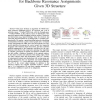401 search results - page 69 / 81 » Sparse Quasi-Random Graphs |
CP
2003
Springer
14 years 28 days ago
2003
Springer
Multiple sequence alignment is a central problem in Bioinformatics. A known integer programming approach is to apply branch-and-cut to exponentially large graph-theoretic models. T...
BIBE
2007
IEEE
14 years 2 months ago
2007
IEEE
Abstract—This paper develops an algorithm for NMR backbone resonance assignment given a 3D structure and a set of relatively sparse 15 N-edited NMR data, with the through-space 1...
MSWIM
2005
ACM
14 years 1 months ago
2005
ACM
Topology Control (TC) is a well-studied technique used in wireless ad hoc networks to find energy-efficient and/or low-interference subgraphs of the maxpower communication graph....
SIGAL
1990
13 years 11 months ago
1990
We propose and analyse a quasirandom analogue to the classical push model for disseminating information in networks ("randomized rumor spreading"). In the classical mode...
DCOSS
2008
Springer
13 years 9 months ago
2008
Springer
This paper studies the problem of associating deterministically a track revealed by a binary sensor network with the trajectory of a unique moving anonymous object, namely the Mult...

